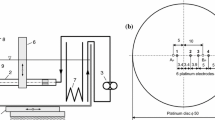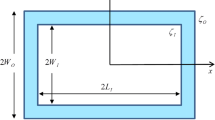Abstract
Three spray systems with multiple nozzles arranged linearly, of different geometrical configurations were tested experimentally: (1) spray nozzles without induction electrodes facing a distant plate, (2) spray nozzles with two parallel bar induction electrodes, and (3) spray nozzles with individual ring induction electrodes. The systems were set to operate at the precession mode of spraying. In all the systems, except that of individual induction electrodes, the precession mode of spraying was first set at peripheral nozzles, and next, for higher voltages, at central nozzles. In the system with ring induction electrodes, the precession mode of spraying was generated for all nozzles at the same voltage level. The size and charge distributions of the droplets were measured for each spray system. The charge distribution of the droplets was measured with a ring induction probe, and it was compared with the charge distribution determined numerically from the size distribution of the droplets, based on the Rayleigh limit formula. It was shown that both these distributions correlate quite well. Free droplets suspended and moving irregularly within the centre of the charged spray plume were observed in the system with individual rings.









Similar content being viewed by others
References
Asano K, Yatsuzuka K (1999) Rotational motion of water ligament drawn by electrostatic force. J Electrostat 46(2–3):69–77
Balachandran W, Krupa A, Machowski W, Jaworek A (2001) Smoke precipitation by charged water aerosols. J Electrostat 51–52:193–199
Balachandran W, Jaworek A, Krupa A, Kulon J, Lackowski M (2003) Efficiency of smoke removal by charged water droplets. J Electrostat 58(3–4):209–220
Hubacz AN, Marijnissen JCM (2003) The scale-up of electrohydrodynamic atomization. J Aerosol Sci 34(Suppl 1):S1269–S1270
Jaworek A (1993) Ring probes for the measurement of charge on a single airborne particle. Trans Inst Fluid Flow Mach 95:131–146
Jaworek A, Krupa A (1996) Generation and characteristics of the precession mode of EHD spraying. J Aerosol Sci 27(1):75–82
Jaworek A, Krupa A (1999a) Jet and drop formation in electrohydrodynamic spraying of liquids. A Syst Approach Exp Fluids 27(1):43–52
Jaworek A, Krupa A (1999b) Classification of the modes of EHD spraying. J Aerosol Sci 30(7):873–893
Jaworek A, Balachandran W, Lackowski M, Kulon J, Krupa A (2006) Multi-nozzle electrospray system for gas cleaning processes. J Electrostat 64(3–4):194–202
Krupa A, Jaworek A, Czech T, Lackowski M, Luckner J (2003) Dust particle removal by wet type electrostatic scrubber. In: Proceedings of the 11th international conference Electrostatics 2003, Edinburgh, 23–27 March, Inst. Phys. Conf. Series No.178
Law SE (2001) Agricultural electrostatic spray application: a review of significant research and development during the 20th century. J Electrostat 51–52:25–42
Law SE, Cooper SC (1988) Depositional characteristics of charged and uncharged droplets applied by an orchard air carrier sprayer. Trans ASAE 31(4):984–989
Law SE, Cooper SC, Law WB (1999) Bipolar spray charging for enhanced deposition onto nonconductive and electrically isolated targets. In: Proceedings of the 10th international conference ELECTROSTATICS ‘99, 28–31 March 1999, Inst. Phys. Conf. Ser. No. 163, Cambridge, 243–248
Rayleigh FRS (1882) On the equilibrium of liquid conducting masses charged with electricity. Phil Mag 14(Ser. 5):184–186
Regele JD, Papac MJ, Rickard MJA, Dunn-Rankin D (2002) Effects of capillary spacing on EHD spraying from an array of cone jets. J Aerosol Sci 32(11):1471–1479
Rulison AJ, Flagan RC (1993) Scale-up of electrospray atomization using linear arrays of Taylor cones. Rev Sci Instrum 64(3):683–686
Snarski SR, Dunn PF (1991) Experiments characterizing the interaction between two sprays of electrically charged liquid droplets. Exp Fluids 11(4):268–278
Ye Q, Domnick J (2003) On the simulation of space charge in electrostatic powder coating with a corona spray gun. Powder Technol 135(Sp.Iss.):250–260
Ye Q, Steigleder T, Scheibe A, Domnick J (2002) Numerical simulation of the electrostatic powder coating process with a corona spray gun. J Electrostat 54(2):189–205
Author information
Authors and Affiliations
Corresponding author
Rights and permissions
About this article
Cite this article
Jaworek, A., Lackowski, M., Krupa, A. et al. Electrostatic interaction of free EHD jets. Exp Fluids 40, 568–576 (2006). https://doi.org/10.1007/s00348-005-0096-3
Received:
Revised:
Accepted:
Published:
Issue Date:
DOI: https://doi.org/10.1007/s00348-005-0096-3




